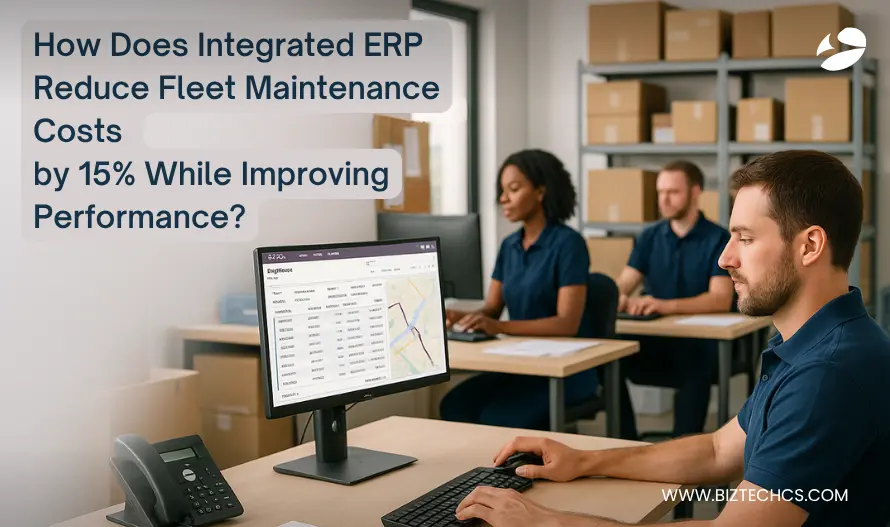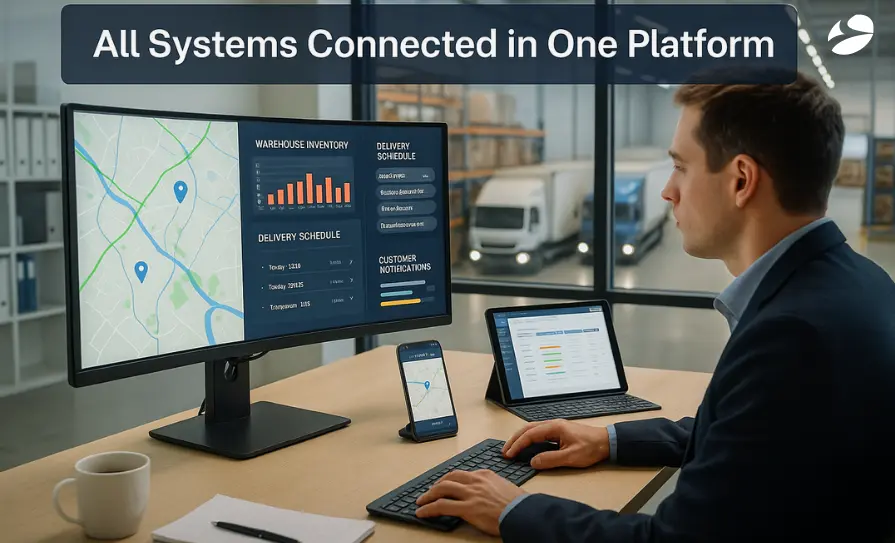
https://www.biztechcs.com/blog/how-does-integrated-erp-reduce-fleet-maintenance-costs-by-15-while-improving-performance/
The UAE logistics sector is booming — in fact, the market value surged to USD 62.08 billion in 2024 (source: Claight Corp+1). Yet, most logistics companies still run their operations like it’s 1999. Spreadsheets are scattered across departments like uninvited confetti at a wedding nobody wanted to attend. The dispatch team uses one system. Fleet maintenance runs on another. Finance? They’ve got their own little kingdom. It’s organisational chaos wearing a business suit.
Manual processes are costing serious time in logistics. According to McKinsey, digital-visibility automation can cut “blind handoffs” in mid and last-mile operations by up to 40% (source: McKinsey & Company). And yet you’re still doing things the old way: your dispatch team uses one system, fleet maintenance another, finance operates in its own silo—essentially Excel chaos in a business suit.
Your competitors who’ve deployed an integrated platform like Odoo fleet management are meanwhile tracking real-time data, optimizing routes, and turning inefficiencies into profit—while you’re still playing phone tag with drivers and drawing delivery lines on printed maps like some ancient cartographer, all while missing out on the powerful advantages of Odoo CRM Integration to streamline customer interactions and improve operational efficiency.
Here’s what burns the most. These disconnected systems cost your logistics operation far more than they should—industry research finds that firms embracing digital tech across their supply chains can reduce costs by 20–30% (source). Your maintenance schedules miss critical updates. Vehicles break down during peak delivery hours. Customer complaints pile up faster than dirty laundry at a teenager’s room.
Meanwhile, companies running Odoo for fleet performance tracking report 15% lower maintenance costs within six months. They achieve 20 % faster delivery times, too. The math isn’t complicated. The solution exists. The question is whether you’ll grab it or keep burning money like it’s going out of style.
What Operational Challenges Do Modern Logistics Companies Face with Disconnected Systems?
When logistics operations run on siloed tools that don’t communicate with each other, the result is a cascade of inefficiencies that affects every level of the supply chain.
The Cost of Fragmented Fleet Management
Running fleet operations across disconnected systems is like trying to conduct an orchestra where every musician is wearing noise-canceling headphones. Manual data updates eat up precious time when your team still relies on Excel spreadsheets and phone calls — and in fact, 16% of logistics professionals say they still operate that way (source: freightwaves.com).
That’s basically paying someone to play corporate telephone all day long. Your team updates the fleet schedule in System A, then copies it to System B, and by the time it reaches System C, half the information has gone on vacation.

Meanwhile, shipments wander off schedule simply because the left hand doesn’t know what the right hand shipped yesterday. Customer satisfaction scores plummet faster than a lead balloon when packages arrive fashionably late or not at all.
The real kicker is that companies trying to implement Odoo fleet management for logistics often discover their biggest enemy isn’t technology — it’s their addiction to juggling fifteen different platforms like a caffeinated circus performer.
Why Manual Processes Create Bottlenecks
Manual tracking systems move at the speed of a sloth on sedatives, a problem that Odoo logistics management for UAE companies solves through intelligent automation, while your competition races ahead with real-time shipment tracking with Odoo. Manual data updates eat up precious hours when your system lacks seamless integration—76% of supply-chain executives say their operations face more frequent disruptions compared with three years ago (Source: Gartner). With Odoo CRM Integration, you can further streamline customer communication, ensuring smoother operations and reducing the risk of delays and errors.
Your logistics coordinator spends Monday morning matching Friday’s delivery reports with Thursday’s dispatch logs while Tuesday’s shipments are already going sideways. But here’s what executives often ask: “Can we really eliminate these manual processes without disrupting our current operations?”
The answer is refreshingly straightforward — a phased implementation allows the parallel operation of old and new systems for 2-3 weeks, ensuring zero operational disruption as your team gradually transitions.
Human error rates in manual tracking hover around 15%, which sounds manageable until you realize that’s one screw-up for every seven deliveries. Decision-makers wait hours for reports that should take minutes because someone has to compile data from six different spreadsheets manually.
The cherry on this disaster sundae is watching opportunities vanish while waiting for yesterday’s performance metrics to improve. Smart companies implementing Odoo for fleet performance tracking discover that automating these processes is like switching from dial-up to fiber-optic internet.
Does your team spend more time reconciling data than actually managing logistics? There’s a better way to handle fleet operations that doesn’t involve manual spreadsheet gymnastics.
The Hidden Costs of Poor System Integration
Poor system integration is the silent profit-killer that makes your accountant weep into their calculator. Inefficient routing increases fuel consumption and asset wear when your systems don’t talk to each other, but the bigger cost is when you’re stuck with reactive maintenance instead of predictive analytics — organisations adopting predictive maintenance reduce maintenance costs by 18-25% (Source).
Drivers zig-zag across cities like they’re playing connect-the-dots blindfolded because nobody thought to integrate route-planning with delivery schedules. Maintenance costs spike when you’re reactive rather than proactive.
Equipment breaks down at the worst possible moments because your maintenance system doesn’t talk to your fleet tracking system, a disconnect that Odoo logistics management for UAE companies eliminates through seamless integration. Customer churn reaches 18% annually when deliveries consistently disappoint, taking their lifetime value straight to your competitors.
Companies optimising delivery routes with Odoo suddenly realise they’ve been hemorrhaging money like a broken ATM all along. Leadership teams frequently wonder: “What’s the actual ROI timeline for implementing integrated ERP?”
Based on BiztechCS implementations, companies typically see positive ROI within 4-6 months, with the initial investment recovered through fuel savings and reduced overtime costs alone—not even counting the customer-retention improvements.
How Can Integrated ERP Systems Transform Logistics Operations?
Bringing every moving part of your logistics workflow into one unified system through Odoo logistics management for UAE companies unlocks a level of control and clarity that fragmented tools simply can’t deliver.
The Power of Centralized Fleet Management
We can implement real-time vehicle tracking systems that make your fleet more visible than a neon sign in the desert. No more playing hide-and-seek with your delivery trucks or wondering if they’ve eloped to another emirate. Automated maintenance scheduling protocols prevent your vehicles from throwing tantrums at the worst possible moments.
The unified dashboard visibility means everyone sees the same picture, rather than creating their own artistic interpretations of reality. Odoo fleet management for logistics companies turns chaos into choreography faster than you can say “where’s my shipment?”

Real-Time Data for Strategic Decision Making
We can configure GPS-enabled route optimization to prevent drivers from taking scenic detours while delivering packages. Predictive analytics for demand forecasting becomes your crystal ball minus the mystical nonsense and questionable accuracy.
The system starts optimizing delivery routes with Odoo like a chess grandmaster planning ten moves ahead. Operational costs drop so dramatically that your finance team might actually crack a smile.
Real-time shipment tracking with Odoo transforms guesswork into precision science, eliminating the need for a PhD in fortune-telling.
Odoo Expert Tip: We recommend configuring Odoo’s automated alerts with escalation matrics based on delivery criticality. Set up three-tier notifications: green (on-track), yellow (15-minute delay), and red (30+ minute delay) with different stakeholder groups receiving relevant alerts. This simple configuration prevents information overload while ensuring critical delays get immediate attention.
Enhancing Customer Experience Through Technology
Automated customer notification systems that we can implement mean customers know their package status before they even think to ask. Self-service tracking portals let customers legally track their packages without calling your support team 17 times. Transparency builds trust faster than a politician breaks promises, except this time you actually deliver on your commitments.
Odoo logistics management for UAE companies fosters happy customers who stay loyal, rather than defecting to competitors. Your reputation improves from “they’ll get there eventually” to “these folks actually have their act together.” With the added benefit of Odoo CRM Integration, you not only streamline your logistics but also enhance customer relationships, ensuring timely communication and personalized service that keeps customers coming back.
What Makes Odoo the Ideal Solution for Logistics Management?
Odoo brings every critical logistics function under one roof, giving growing companies the flexibility and control traditional systems struggle to deliver.
Comprehensive Fleet Management Capabilities
Vehicle lifecycle management features track everything from the birth certificate to the retirement party for each truck in your fleet. Driver performance-tracking modules reveal who’s treating company vehicles like Formula 1 cars and who’s actually following the speed limit. Fuel consumption optimization tools expose which vehicles are drinking diesel like it’s happy hour at a gas station.
Odoo for fleet performance tracking basically becomes your fleet’s personal fitness trainer, except it actually works. A common concern from operations heads is: “How complex is the training for our existing staff who aren’t tech-savvy?”
We address this with role-based training modules that take just 3-5 hours per user, with most drivers mastering the mobile app in under an hour. It’s designed to be simpler than ordering food delivery online.
Seamless Integration Possibilities
We can seamlessly integrate Odoo with existing GPS systems, so smoothly that your tech stack won’t even notice the integration. Warehouse management finally comes together with fleet operations, rather than giving each other the cold shoulder.
API capabilities for third-party tools mean your favorite software can join the party without crashing it. Real-time shipment tracking with Odoo becomes a reality instead of another broken promise on your website.

Scalability for Growing Operations
The modular approach lets you implement features like eating chips, one at a time, without choking on the whole bag. Cost-effectiveness compared to custom solutions allows your procurement team to stop worrying about budget overruns.
Future-proofing logistics operations with Odoo logistics management for UAE companies means you won’t need another system overhaul when your business doubles next year. Management often asks: “What happens when we expand to new emirates or add 50 more vehicles?” The beauty of Odoo’s modular architecture is that scaling up requires just configuration changes, not infrastructure overhauls – companies have scaled from 20 to 200 vehicles without changing their core setup.
Odoo logistics management for UAE companies grows with you like a well-trained bonsai tree, except faster and with less pruning required.
How Can BiztechCS Implement the Three-Phase Transformation Strategy?
We can execute a structured rollout that turns complex change into a clear, step-by-step evolution instead of a disruptive overhaul.
Phase 1: Establishing Centralized Fleet Control with Odoo Logistics Management for UAE Companies
We can introduce a comprehensive fleet tracking dashboard that makes outdated systems look like cave paintings with stick figures. Automated maintenance scheduling can be configured—because waiting for trucks to break down is about as smart as using a chocolate teapot. Performance monitoring KPIs can highlight which vehicles are the true workhorses and which ones are basically expensive paperweights on wheels.
With the right training, your operations team can go from Excel warriors to dashboard ninjas within weeks. Resistance to change? It tends to melt faster than ice cream in the Dubai summer once users see Odoo fleet management in action. No more twenty questions about vehicle locations—everything can be available on-screen, in real time.
Within weeks, your team could be managing fleets like they were born with GPS coordinates in their DNA.
Phase 2: Enabling Real-Time Shipment Visibility
We can integrate GPS tracking with the Odoo logistics module so seamlessly that even if a truck tries to join a witness protection program, it won’t escape the map. Custom delivery status workflows can be built to reflect real-world movement, not wishful thinking and prayer.
Route optimization algorithms can start planning deliveries like a military strategist preparing for desert warfare. A mobile app for drivers can eliminate the classic “the dog ate my delivery log” excuse forever. Real-time shipment tracking won’t just be a feature—it can be a new standard everyone willingly adopts. Drivers who once treated route suggestions like fortune cookie advice could become efficiency evangelists.
The entire logistics engine can run like a well-oiled machine instead of grinding like rusty gears in a sandstorm. And when the C-suite inevitably asks: “How do we keep this running without relying on a vendor forever?” We can build self-sufficiency right into the implementation—with admin training, documentation, and a gradual handover so your team fully owns the system within 90 days.
Odoo Expert Tip: We always implement Odoo’s geofencing feature with customized zones around delivery hotspots and customer locations. Configure automatic status updates when vehicles enter/exit these zones – this eliminates 90% of manual status updates while providing granular visibility. The key is setting zone radiuses between 100-200 meters for optimal accuracy without false triggers.
Phase 3: Revolutionizing Customer Communication
In the final phase, we can move beyond visibility and control into full-scale optimization. Predictive analytics can help forecast maintenance needs, fuel usage, delivery delays, and seasonal demand spikes—before they happen.
We can set up automated cost-saving insights so your team doesn’t have to dig through spreadsheets like archaeologists searching for lost treasure. IoT and telematics data can be connected to Odoo, turning every vehicle into a real-time data source instead of a moving mystery box.
Custom dashboards can be designed for every decision-maker—from fleet managers to C-level execs—so nobody is guessing, everyone is informed, and strategy becomes data-driven, not instinct-driven. With performance benchmarking, the system can flag top-performing routes, drivers, and assets, while also exposing inefficiencies that quietly burn cash in the background.
And because optimization is never “one and done,” we can build a continuous improvement loop—where your team learns, adapts, and scales without needing to restart from zero every year. By the end of Phase 3, your logistics ecosystem won’t just be modern—it can be intelligent, proactive, and constantly learning.
Closing Lines
The logistics nightmare of disconnected systems, manual tracking chaos, and hemorrhaging profits doesn’t have to be your company’s permanent address. Our three-phase approach can transform spreadsheet purgatory into an operational paradise without requiring a second mortgage or sacrificing your firstborn to the tech gods.
From establishing centralized control to revolutionizing customer communication, Odoo logistics management for UAE companies has proven that integration beats desperation every single time. The numbers don’t lie, even when your old systems did. Twenty percent faster deliveries, fifteen percent lower maintenance costs, and customer satisfaction scores that finally stopped making people cry.
Real-time shipment tracking with Odoo turned wishful thinking into actual tracking. Optimizing delivery routes with Odoo stopped drivers from exploring every street in the emirate. The transformation journey from logistics chaos to coordinated excellence takes weeks, not years.
Your competitors are already halfway there while you’re still playing Excel ping-pong with delivery schedules.
BiztechCS has the battle scars and success stories to prove that Odoo fleet management for logistics companies actually delivers what it promises. The question isn’t whether you can afford to implement this solution; rather, it is whether you can afford not to. It’s whether you can afford to keep bleeding money while pretending everything’s fine.
Ready to stop the operational bleeding and start seeing real results within 12 weeks? Your competition is already moving forward while you’re still juggling spreadsheets.
11
26 Nov, 2025
5 min read







